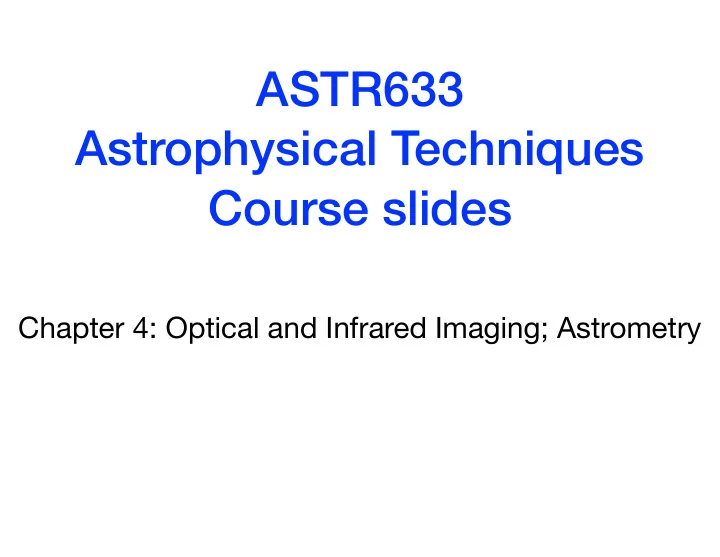

ASTR633 Astrophysical Techniques Course slides Chapter 4: Optical and Infrared Imaging; Astrometry
Optical camera schematic Figure 4.1
Field correcting optics Figure 4.2
Refraction n i sin Z i = n ( i − 1) sinZ ( i − 1) =>
P 0 = 760 mm, T 0 = 288 K
Chromatic Aberration Note scale!!! A ff ects images and spectroscopy Kaczmarczik et al. 2009, AJ, 138, 19
Differential Chromatic Aberration Kaczmarczik et al. 2009, AJ, 138, 19
Near-infrared camera Multiple mirrors fold light path and enable cold optics and small filters but also lead to vignetting and ghost images For more details, talk to Klaus Hodapp, or take his instrumentation course! Figure 4.3
Nyquist sampling aliasing => want pixel angular size on sky < λ /2D Figure 4.4
Why image?(!)
How to take good data Repetition Consistency
Calibration i.e., how to make a uniform image so that a star would have the same value if it were moved to a di ff erent part of the image • Multiple dithered exposures • Bias frame (or “o ff set”) • Dark frame • Flat field (possibly created from data => “response”) • Pre-process to remove read-out artifacts • Median filter to remove cosmic rays Note that the book assumes response created from data and therefore has the same integration time. If you use a separate flat field, scale counts appropriately by integration time.
Coordinate Systems: horizon a.k.a. “alt-az”
Coordinate Systems: horizon a.k.a. “alt-az” Advantages: • Things like to be built perpendicular to local gravity. E.g. often used as reference frame to describe where telescopes are physically pointed. • Stars are only visible with altitude > 0° Disadvantages: • Coordinates of stars depend on observing location, because the Earth is really a sphere, not a plane. • Even at one specific site, the position of a star varies with time as the Earth rotates.
Coordinate Systems: equatorial
Coordinate Systems: equatorial Spherical trigonometry gives the conversion between alt-az and HA- δ , given your latitude, φ North Star = Hokupa’a in Hawaiian = “star that never moves”
The book that almost killed my high school interest in astronomy…
Coordinate Systems: equatorial https://en.wikipedia.org/wiki/Right_ascension
Coordinate Systems: Ecliptic https://en.wikipedia.org/wiki/Ecliptic_coordinate_system
Coordinate Systems: Galactic https://commons.wikimedia.org/w/index.php?curid=20028939
Coordinate Transformations http://docs.astropy.org/en/stable/coordinates/
Time Solar and sidereal time di ff er by one day over one year (i.e. stars rise 4 minutes earlier each day). Local Sidereal Time, LST = 0 h when the Vernal Equinox is on the observer’s meridian
Time HA = LST - RA Negative hour angles mean the source is rising, positive => setting Qu: What is the RA of a transiting source?
Practical matters for the Observer At the telescope: • LST (software) clock tells the RA of objects that are transiting. This provides the quick initial guide to what is observable at that moment. • The δ of the target and its hour angle (= LST – RA) determines the altitude of the target. At HA=0, the target is transiting and at maximum altitude. • It is preferable to observe targets when they are high in the sky, i.e. high altitude = small zenith angle = low airmass, due to better image quality and less atmospheric absorption. Altitude > 30° (airmass < 2.0) is the typical practical limit. • At Mauna Kea (latitude = 20°), this means targets with δ > -40° can be observed. Of course, you can go to more southern targets if you are desperate. • The observing “window” (duration above 30° altitude) depends on δ . Targets with δ similar to your latitude have the longest window. • Remember the factor of 15 conversion between RA(sec of time) and RA (arcsec). • Remember the cos δ term when computing the RA o ff set from 1 position to another.
Precession https://en.wikipedia.org/wiki/Precession
Nutation https://en.wikipedia.org/wiki/Nutation
FITS headers RA(i) = CRVAL1 + (i — CRPIX1) * CDELT1 i = 1, 2, 3,… NAXIS1 More generally, CD1_1, etc provide a matrix transformation between pixel (i,j) and sky position (x,y) — see Griesen et al. 2002
Movement within the ICRS
Stellar Aberration http://cseligman.com/text/history/bradley.htm
Stellar Aberration https://commons.wikimedia.org/wiki/File:Stellar_aberration.JPG
Stellar Aberration
Parallax and Aberration http://cseligman.com/text/history/bradley.htm
Recommend
More recommend